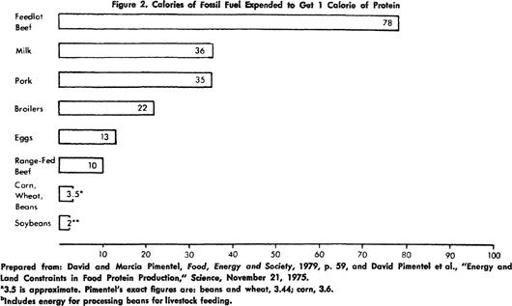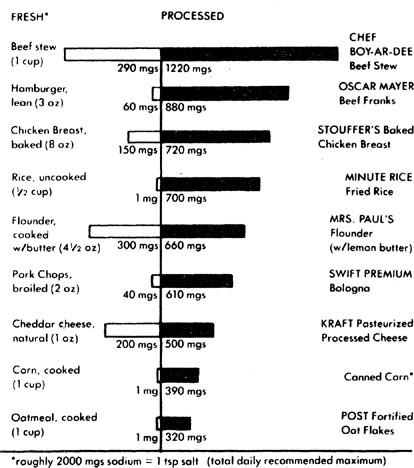Hope's Edge: The Next Diet for a Small Planet (14 page)
Read Hope's Edge: The Next Diet for a Small Planet Online
Authors: Frances Moore Lappé; Anna Lappé
Tags: #Health & Fitness, #Political Science, #Vegetarian, #Nature, #Healthy Living, #General, #Globalization - Social Aspects, #Capitalism - Social Aspects, #Vegetarian Cookery, #Philosophy, #Business & Economics, #Globalization, #Cooking, #Social Aspects, #Ecology, #Capitalism, #Environmental Ethics, #Economics, #Diets, #Ethics & Moral Philosophy

The Livestock Explosion and the Illusion of Cheap Grain
If we are feeding millions of tons of grain to livestock, it must be because it makes economic sense. Indeed, it does “make sense” under the rules of our economy. But that fact might better be seen as the problem, rather than the explanation that should put our concerns to rest. We got hooked on grain-fed meat just as we got hooked on gas-guzzling automobiles. Big cars “made sense” only when oil was cheap; grain-fed meat “makes sense” only because the true costs of producing it are not counted.
But why is grain in America so cheap? If grain is cheap simply because there is so much of it and it will go to waste unless we feed it to livestock, doesn’t grain-fed meat represent a sound use of our resources? Here we need to back up to another, more basic question: why is there so much grain in the first place?
In our production system each farmer must compete against every other farmer; the only way a farmer can compete is to produce more. Therefore, every farmer is motivated to use any new technology—higher yielding seeds, fertilizers, or machines—which will grow more and require less labor. In the last 30 years crop production has virtually doubled as farmers have adopted hybrid seeds and applied ever more fertilizer and pesticides. Since the 1940s fertilizer use has increased fivefold, and corn yields have tripled.
But this production imperative is ultimately self-defeating. As soon as one farmer adopts the more productive technology, all other farmers must do the same or go out of business. This is because those using the more productive technology can afford to sell their grain at a lower price, making up in volume what they lose in profit per bushel. That means constant downward pressure on the price of grain.
Since World War II real grain prices have sometimes fluctuated wildly, but the indisputable trend has been downward. The price of corn peaked at $6.43 per bushel in 1947 and fell to about $2.00 in 1967. In the early 1970s prices swung wildly up, but then fell to a low of $1.12 in 1977, or about
one-sixth the price 30 years earlier
. (All prices are in 1967 dollars.)
23
This production imperative doesn’t fully explain why production of feed doubled after 1950. In the 1950s the problem of agricultural surplus was seen as too much of certain crops, such as wheat, cotton, and tobacco; so government programs subsidized cutbacks of certain crops, but allowed farmers to expand their acreage in others, such as the feed crops barley, soybeans, and grain sorghum. In Texas, for example, sorghum production leaped sevenfold after cotton acreage was limited by law in the 1950s.
24
But neglected in this explanation of the low price of grain are the hidden production costs which we and future generations are subsidizing: the fossil fuels and water consumed, the groundwater mined, the topsoil lost, the fertilizer resources depleted, and the water polluted.
Fossil Fuel Costs
Agricultural production uses the equivalent of about 10 percent of all of the fossil fuel imported into the United States.
25
Besides the cost of the grain used to produce meat, we can also measure the cost of the fossil fuel energy used compared with the food value we receive. Each calorie of protein we get from feedlot-produced beef costs us 78 calories of fossil fuel, as we learn from
Figure 2
, prepared from the work of Drs. Marcia and David Pimentel at Cornell. Grains and beans are from 22 to almost 40 times less fossil-fuel costly.

Figure 2. Calories of Fossil Fuel Expended to Get 1 Calorie of Protein
Enough Water to Float a Destroyer
“We are in a crisis over our water that is every bit as important and deep as our energy crisis,” says Fred Powledge, who has just written the first in-depth book on our national water crisis.
*
According to food geographer Georg Borgstrom, to produce a 1-pound steak requires 2,500 gallons of water!
26
The average U.S. diet requires 4,200 gallons of water a day for each person, and of this he estimates animal products account for over 80 percent.
27
“The water that goes into a 1,000-pound steer would float a destroyer,”
Newsweek
recently reported.
28
When I sat down with my calculator, I realized that the water used to produce just 10 pounds of steak equals the household consumption of my family for the entire year.
Figure 3
, based on the estimates of David Pimentel at Cornell, shows that to produce 1 pound of beef protein can require as much as fifteen times the amount of water needed to produce the protein in plant food.
M
INING
O
UR
W
ATER
Irrigation to grow food for livestock, including hay, corn, sorghum, and pasture, uses 50 out of every 100 gallons of water “consumed” in the United States.
*
29
Other farm uses—mainly irrigation for food crops—add another 35 gallons, so agriculture’s total use of water equals 85 out of every 100 gallons consumed. (Water is “consumed” when it doesn’t return to our rivers and streams.)
Over the past fifteen years grain-fed-beef production has been shifting from the rain-fed Corn Belt to newly irrigated acres in the Great Plains. Just four Great Plains states, Nebraska, Kansas, Oklahoma, and Texas, have accounted for over three-fourths of the new irrigation since 1964, and most of that irrigation has been used to grow more feed. Today half of the grain-fed beef in the United States is produced in states that depend for irrigation on an enormous underground lake called the Ogallala Aquifer.
30

Figure 3. Amount of Water to Produce 1 Pound of Protein from Various Food Sources
But much of this irrigation just can’t last.
Rainwater seeps into this underground lake so slowly in some areas that scientists consider parts of the aquifer a virtually nonrenewable resource, much like oil deposits. With all the new irrigation, farmers now withdraw more water each year from the Ogallala Aquifer than the entire annual flow of the Colorado River. Pumping water at this rate is causing water tables to drop six inches a year in some areas, six feet a year in others. And lower water tables mean higher and higher costs to pump the water. The Department of Agriculture predicts that in 40 years the number of irrigated acres in the Great Plains will have shrunk by 30 percent.
31
In only two decades Texans have used up one-quarter of their groundwater.
32
Already some wells in northern Texas are running dry, and with rising fuel costs, farmers are unable to afford pumping from deeper wells. Why is this water being mined in Texas? Mostly to grow sorghum for the feedlots which have sprung up in the last decade.
When most of us think of California’s irrigated acres, we visualize lush fields growing tomatoes, artichokes, strawberries, and grapes. But in California, the biggest user of underground water, more irrigation water is used for feed crops and pasture than for all these specialty crops combined. In fact, 42 percent of California’s irrigation goes to produce livestock.
33
Not only are water tables dropping, but in some parts of California the earth itself is sinking as groundwater is drawn out. According to a 1980 government survey, 5,000 square miles of the rich San Joaquin Valley have already sunk, in some areas as much as 29 feet.
34
The fact that water is free encourages this mammoth waste. Whoever has the $450 an acre needed to level the land and install pumping equipment can take groundwater for nothing. The replacement cost—the cost of an equal amount of water when present wells have run dry—is not taken into consideration. This no-price, no-plan policy leads to the rapid depletion of our resources, bringing the day closer when alternatives must be found—but at the same time postponing any search for alternatives.
Ironically, our tax laws actually entice farmers to mine groundwater. In Texas, Kansas, and New Mexico, landowners get a depletion allowance on the groundwater to compensate for the fact that their pumping costs rise as their groundwater mining lowers the water table. Moreover, the costs of buying the equipment and sinking the well are tax-deductible. Irrigation increases the value of the land enormously, but when the land is sold the profits from the sale are taxed according to the capital gains provisions; that is, only 40 percent of the difference between the original cost of the farm and its sale price is taxed as ordinary income. The rest is not taxed at all.
Few of us—and certainly not those whose wealth depends on the mining of nonrenewable resources—can face the fact that soon we will suffer for this waste of water. Donald Worster, author of
Dust Bowl: The Southern Plains in the 1930’s
(New York: Oxford University Press, 1979), interviewed a landowner in Haskell County, Kansas, where $27.4 million in corn for feed is produced on about 100,000 acres of land irrigated with groundwater. He asked one of the groundwater-made millionaires, “What happens when the irrigation water runs out?”
“I don’t think that in our time it can,” the woman replied. “And if it does, we’ll get more from someplace else. The Lord never intended us to do without water.”
35
The Soil in Our Steaks
Most of us think of soil as a renewable resource. After all, in parts of Europe and Asia, haven’t crops been grown on the same land for thousands of years? It’s true, soil should be a renewable resource; but in the United States, we have not allowed it to be.
We are losing two bushels of topsoil for every bushel of corn harvested on Iowa’s sloping soils, warned Iowa state conservation official William Brune in 1976.
36
Few listened. “It can take 100 to 500 years to create an inch of topsoil,” but under current farming practices in Iowa, an inch of topsoil “can wash away in a single heavy rainstorm,” Brune said after the spring rains in 1980. On many slopes in Iowa we have only six inches of topsoil left.
37
Few would argue with Brune. Few would dispute that our topsoil loss is a national catastrophe, or that in the last two decades we have backpedaled on protecting our topsoil, or that in some places erosion is as bad as or worse than during the Dust Bowl era. Few dispute that excessive erosion is reducing the soil’s productive capacity, making chemical fertilizers ever more necessary while their cost soars. The only dispute is how many billions of dollars topsoil erosion is costing Americans and how soon the impact will be felt in higher food prices and the end of farming on land that could have been abundant for years to come.
Since we began tilling the fields in our prime farming states we have lost one-third of our topsoil.
38
Each year we lose nearly 4 billion tons of topsoil from cropland, range, pasture, and forest land just because of rain-related water erosion.
39
That 4 billion tons could put two inches of topsoil on all of the cropland in Pennsylvania, New York, and New Jersey.
40
Adding wind erosion, estimated at 3 billion tons, we hit a total erosion figure of nearly 7 billion tons a year.
41
